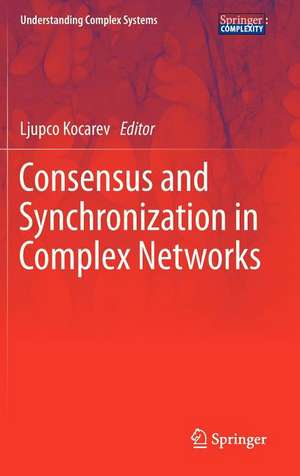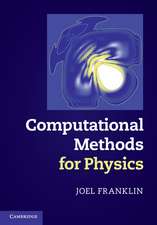Consensus and Synchronization in Complex Networks: Understanding Complex Systems
Editat de Ljupco Kocareven Limba Engleză Hardback – 16 ian 2013
In networks of dynamic systems (or agents), consensus means to reach an agreement regarding a certain quantity of interest that depends on the state of all dynamical systems (agents). Consensus problems have a long history in control theory and computer sciences, and form the foundation of the field of distributed computing. Synchronization, which defines correlated-in-time behavior between different processes and roots going back to Huygens to the least, is now a highly popular, exciting and rapidly developing topic, with applications ranging from biological networks to mathematical epidemiology, and from processing information in the brain to engineering of communications devices.
The book reviews recent finding in both fields and describes novel approaches to consensus formation, where consensus is realized as an instance of the nonlinear dynamics paradigm of chaos synchronization. The chapters are written by world-known experts in both fields and cover topics ranging from fundaments to various applications of consensus and synchronization.
| Toate formatele și edițiile | Preț | Express |
|---|---|---|
| Paperback (1) | 640.06 lei 6-8 săpt. | |
| Springer Berlin, Heidelberg – 26 iun 2015 | 640.06 lei 6-8 săpt. | |
| Hardback (1) | 646.30 lei 6-8 săpt. | |
| Springer Berlin, Heidelberg – 16 ian 2013 | 646.30 lei 6-8 săpt. |
Din seria Understanding Complex Systems
- 18%
 Preț: 1112.30 lei
Preț: 1112.30 lei -
 Preț: 439.25 lei
Preț: 439.25 lei - 18%
 Preț: 1119.38 lei
Preț: 1119.38 lei - 15%
 Preț: 401.82 lei
Preț: 401.82 lei - 18%
 Preț: 1247.26 lei
Preț: 1247.26 lei - 15%
 Preț: 641.20 lei
Preț: 641.20 lei - 15%
 Preț: 642.68 lei
Preț: 642.68 lei - 15%
 Preț: 651.51 lei
Preț: 651.51 lei - 18%
 Preț: 946.55 lei
Preț: 946.55 lei - 18%
 Preț: 947.98 lei
Preț: 947.98 lei - 20%
 Preț: 650.27 lei
Preț: 650.27 lei - 18%
 Preț: 952.09 lei
Preț: 952.09 lei - 18%
 Preț: 957.13 lei
Preț: 957.13 lei - 18%
 Preț: 943.88 lei
Preț: 943.88 lei -
 Preț: 398.35 lei
Preț: 398.35 lei - 5%
 Preț: 1417.54 lei
Preț: 1417.54 lei - 15%
 Preț: 648.42 lei
Preț: 648.42 lei -
 Preț: 387.75 lei
Preț: 387.75 lei - 18%
 Preț: 1133.76 lei
Preț: 1133.76 lei - 18%
 Preț: 948.16 lei
Preț: 948.16 lei - 20%
 Preț: 655.85 lei
Preț: 655.85 lei - 18%
 Preț: 1113.09 lei
Preț: 1113.09 lei - 20%
 Preț: 655.53 lei
Preț: 655.53 lei - 15%
 Preț: 653.00 lei
Preț: 653.00 lei - 18%
 Preț: 1392.77 lei
Preț: 1392.77 lei - 18%
 Preț: 1010.48 lei
Preț: 1010.48 lei - 18%
 Preț: 955.56 lei
Preț: 955.56 lei -
 Preț: 384.22 lei
Preț: 384.22 lei - 18%
 Preț: 950.66 lei
Preț: 950.66 lei - 15%
 Preț: 638.43 lei
Preț: 638.43 lei - 15%
 Preț: 644.49 lei
Preț: 644.49 lei - 15%
 Preț: 647.40 lei
Preț: 647.40 lei - 15%
 Preț: 649.06 lei
Preț: 649.06 lei - 15%
 Preț: 639.25 lei
Preț: 639.25 lei - 15%
 Preț: 643.65 lei
Preț: 643.65 lei - 18%
 Preț: 960.78 lei
Preț: 960.78 lei - 15%
 Preț: 649.87 lei
Preț: 649.87 lei - 15%
 Preț: 645.47 lei
Preț: 645.47 lei
Preț: 646.30 lei
Preț vechi: 760.35 lei
-15% Nou
Puncte Express: 969
Preț estimativ în valută:
123.67€ • 129.45$ • 102.93£
123.67€ • 129.45$ • 102.93£
Carte tipărită la comandă
Livrare economică 01-15 aprilie
Preluare comenzi: 021 569.72.76
Specificații
ISBN-13: 9783642333583
ISBN-10: 3642333583
Pagini: 288
Ilustrații: IX, 275 p.
Dimensiuni: 155 x 235 x 21 mm
Greutate: 0.58 kg
Ediția:2013
Editura: Springer Berlin, Heidelberg
Colecția Springer
Seria Understanding Complex Systems
Locul publicării:Berlin, Heidelberg, Germany
ISBN-10: 3642333583
Pagini: 288
Ilustrații: IX, 275 p.
Dimensiuni: 155 x 235 x 21 mm
Greutate: 0.58 kg
Ediția:2013
Editura: Springer Berlin, Heidelberg
Colecția Springer
Seria Understanding Complex Systems
Locul publicării:Berlin, Heidelberg, Germany
Public țintă
ResearchCuprins
Consensus theory in networked systems.- Control of Networks of Coupled Dynamical Systems.- Distributed consensus and coordination control of networked multi-agent systems.- Consensus of Networked Multi-Agent Systems with Delays and Fractional-Order Dynamics.- Synchronization in complex networks: properties and tools.- Enhancing Synchronizability of Complex Networks via Optimization.- Synchronization-based parameter estimation in chaotic dynamical systems.- Data Assimilation as Artificial Perception and Supermodeling as Artificial Consciousness.- Supermodeling dynamics and learning mechanisms.- On the limit of large couplings and weighted averaged dynamics.
Recenzii
From the reviews:
“This book contains ten papers that discuss different aspects of consensus and synchronization problems in complex networks. … The book is targeted to an audience that works on synchronization problems. The editor and authors have tried to introduce this audience to existing work on consensus problems. It is certainly suitable for such an audience.” (Burkhard Englert, Computing Reviews, June, 2013)
“This book contains ten papers that discuss different aspects of consensus and synchronization problems in complex networks. … The book is targeted to an audience that works on synchronization problems. The editor and authors have tried to introduce this audience to existing work on consensus problems. It is certainly suitable for such an audience.” (Burkhard Englert, Computing Reviews, June, 2013)
Textul de pe ultima copertă
Synchronization in complex networks is one of the most captivating cooperative phenomena in nature and has been shown to be of fundamental importance in such varied circumstances as the continued existence of species, the functioning of heart pacemaker cells, epileptic seizures, neuronal firing in the feline visual cortex and cognitive tasks in humans. E.g. coupled visual and acoustic interactions make fireflies flash, crickets chirp, and an audience clap in unison.
On the other hand, in distributed systems and networks, it is often necessary for some or all of the nodes to calculate some function of certain parameters, e.g. sink nodes in sensor networks being tasked with calculating the average measurement value of all the sensors or multi-agent systems in which all agents are required to coordinate their speed and direction. When all nodes calculate the same function of the initial values in the system, they are said to reach consensus. Such concepts - sometimes also called state agreement, rendezvous, and observer design in control theory - have recently received considerable attention in the computational science and engineering communities. Quite generally, consensus formation among a small group of expert models of an objective process is challenging because the separate models have already been optimized in their own parameter spaces.
The mathematical framework for describing synchronization and consensus in natural and technical sciences is similar and the aim of this book is to provide the first comprehensive work in which synchronization andconsensus are presented jointly, thereby allowing the reader to learn about the similarities and differences of the two concepts in both a systematic and application-oriented fashion. The ten chapters have been carefully selected so as to reflect the current state-of-the-art of synchronization and consensus in networked systems; in particular two chapters dealing with a novel application of synchronization concepts in machine learning have been included.
The book is aimed at all scientists and engineers, graduate students and practitioners, working in the fields of synchronization and related phenomena.
On the other hand, in distributed systems and networks, it is often necessary for some or all of the nodes to calculate some function of certain parameters, e.g. sink nodes in sensor networks being tasked with calculating the average measurement value of all the sensors or multi-agent systems in which all agents are required to coordinate their speed and direction. When all nodes calculate the same function of the initial values in the system, they are said to reach consensus. Such concepts - sometimes also called state agreement, rendezvous, and observer design in control theory - have recently received considerable attention in the computational science and engineering communities. Quite generally, consensus formation among a small group of expert models of an objective process is challenging because the separate models have already been optimized in their own parameter spaces.
The mathematical framework for describing synchronization and consensus in natural and technical sciences is similar and the aim of this book is to provide the first comprehensive work in which synchronization andconsensus are presented jointly, thereby allowing the reader to learn about the similarities and differences of the two concepts in both a systematic and application-oriented fashion. The ten chapters have been carefully selected so as to reflect the current state-of-the-art of synchronization and consensus in networked systems; in particular two chapters dealing with a novel application of synchronization concepts in machine learning have been included.
The book is aimed at all scientists and engineers, graduate students and practitioners, working in the fields of synchronization and related phenomena.
Caracteristici
Brings together research in consensus formation and synchronization in communication networks Edited and authored by leading researchers in the field Suitable as introduction to nonspecialists Includes supplementary material: sn.pub/extras














